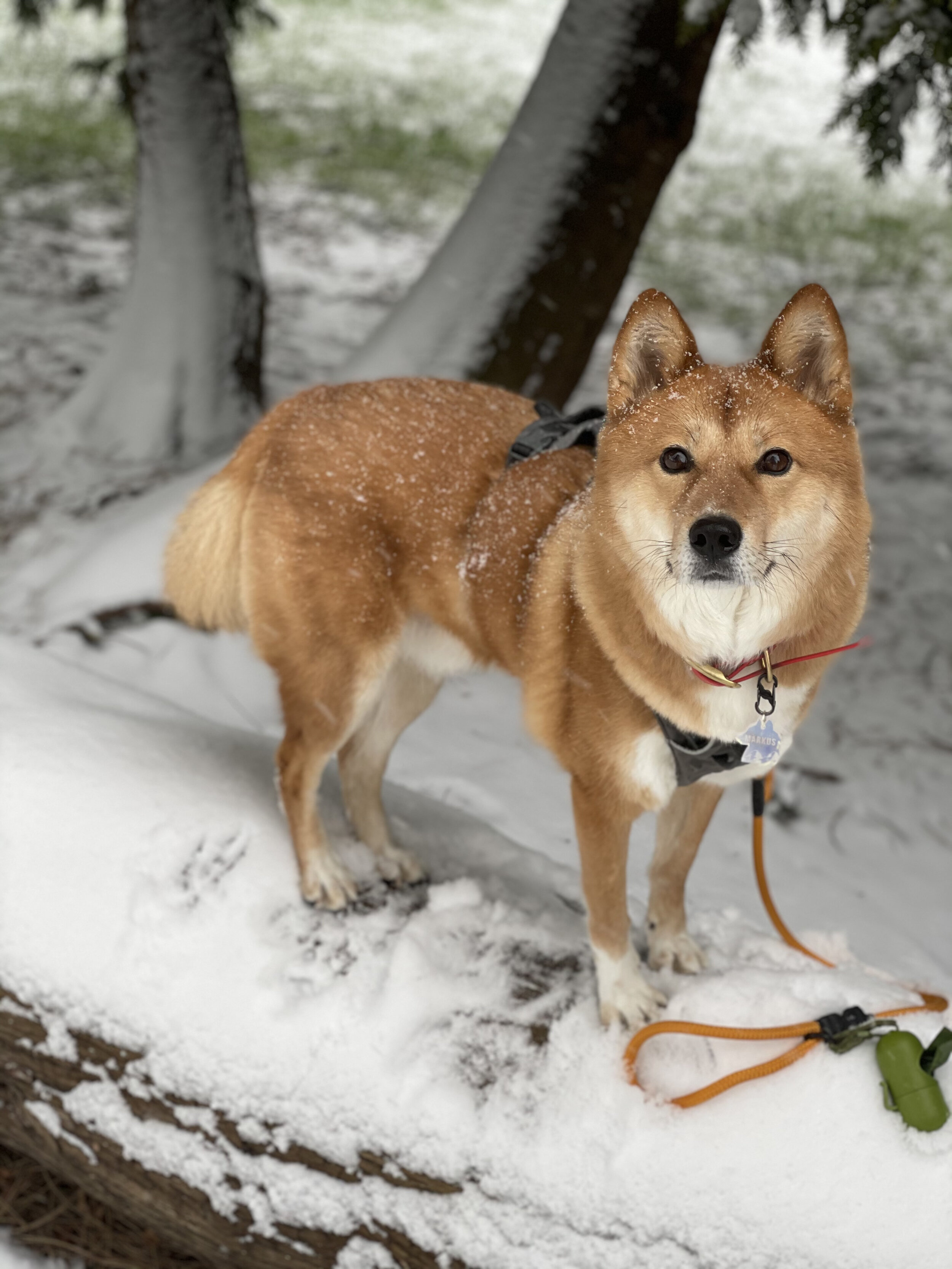Snow Day!
Markus with snow slowly falling on his head
It's the end of February and we finally got the first snow dump of the season! In the past weeks and months, we had a few days where we had snow in the forecast, but this was the first time the snow stuck and we woke up to a white wonderland.
Most years, the amusement of snow gets old rather quickly - when you have to drive or walk through it to get to work and back, it quickly becomes a nuisance. But in a COVID-19 reality where we seem to be reliving the same day over and over again, being able to go out into the snow with our dog was a welcomed change.
That first moment when a dog sees the snow is the best - you open the door and they see all the white out and think wait what's this? So for this update, we wanted to give a few pointers and signs to look out for before going out to play in the snow so that you and your dog can stay safe and have fun!
The Salt Thing
Before we had a dog of our own, we appreciated the people who took the time to salt the front of their property. As a pedestrian, those short stretches where we didn't have to worry about slipping in the snow and could walk safely on cleared and melted sidewalks were so great. But since we've had a dog of our own, the salt which was once such a relief has become something that we sometimes actively avoid.
Used for melting snow on the sidewalk, these salt chunks come in all shapes and sizes (and colours!). Some owners will use table salt from their pantry whereas others will purchase designated bags of sidewalk salt that tend to come in larger chunks. While salt isn't an issue for pedestrians with shoes or thick snow boots on, they are an issue for our dogs and their bare paws for a few reasons.
If you've ever had wet salt on your hands for too long, you'll know it's not a great feeling. The saying, "rub salt on the wound" exists because it's an unpleasant feeling, especially if there's an open area on your skin. Even if you don't have something like a cut, getting salt water under your nails also doesn't feel great. While your dog probably doesn't have an open wound either, their paws can be raw from walking on the snow or the ice and melted/wet salt can make its way into openings that we are aware about like their nails.
Depending on the size of the salt and if they're big enough, they can also get lodged and stuck in your dog's paws. If something's stuck and it hurts to walk, your dog will let you know and they'll likely start to walk weird, trying to knock the salt loose. If this happens, just pause and help your dog dislodge the salt from their foot. It's like having a rock in your shoe, but worse since it's stuck in the same spot!
And sometimes the salt can stick to your dog without any visible effect until later. Perhaps they're smaller grains like table salt or maybe it lodged between the toes and it doesn't affect the dog's walking. As dog owners, we need to be aware of this because it's potentially dangerous.
Some dogs will try to lick their paws clean once they get home. If they have something stuck in between their toes, they may not have felt it annoying enough to deal with while on the walk, but they will when they're back at home. This can be especially dangerous because some sidewalk salt have chemicals mixed in them so that the ice melts faster. Some of them are easy to tell because of they come in a bluish hue, but you won't be able to tell with all of them and we need to be aware of this.
Out of habit, we will almost always wipe the paws clean at the end of a walk, but if there was salt along the way, we'll take a warm cloth and try to get in between the toes to dislodge anything that might've gotten stuck during the walk. A little habit like this can go a long way to making sure the dog's not ingesting anything they shouldn't!
Digging in the snow
Our dog's not a digger so we find it quite amusing when he starts to dig through the snow. If there's a clump of snow like a big snowball, he'll make it a point to dig at it until it's collapsed. We're not sure why he does that, but since that's the only time we ever see him dig, it's kind of interesting to watch him dig with so much purpose.
Beyond the from digging, we've also noticed that he'll also clear out areas so he can do his business. In the snow, he'll remove the snow to expose a small patch of grass and that's where he ends up pooping. It would appear that he doesn't like to make yellow snow.
While all this type of digging is fine, there is one thing that dogs will do that we need to pay attention to. It is when they think they've found something (because there's a good chance they have) beneath the snow and start to dig for it! Just because there's a layer of snow on top and we don't see it doesn't mean the dog's not going to know it's there.
We only realized this because we saw some poop that another dog left below one of the light posts by the park. The next day with snow having fallen to put a white layer on everything, our dog went digging and sticking his nose into that very spot. Even though we couldn't see what he was digging for, we knew there was poop underneath because we had seen it the previous day.
While another dog's poop is unpleasant, it's also not the worst thing for a dog to get into. Sometimes there could be food or something either that we don't want our dogs to get into. We really can't know what's underneath, so just be aware of when the digging for fun switches to digging to get something.
Listen to your dog
Markus has two coats of fur, ready to take on the snow!
At the end of the day and when it comes to snow, the thing that we need to remember is that not all dogs are the same, which should go without saying. The different breeds of dogs have different characteristics to help them deal with the cold. Some dogs like ours even have two coats of fur to keep them warm when it gets cold out (with intense shedding seasons when it's not). Other breeds hardly have any visible fur and all of these dogs will experience the cold differently.
There's no sweeping one-size-fits-all solution, but our recommendation is just to watch your dog and how they respond to the cold. Even if your dog has a lot of fur, it doesn't automatically mean they're good in the cold. Like humans, we run in different temperatures and the cold affects a dog in negative ways that we need to be mindful about.
Of the things to look out for, there are telltale signs like shivering and short, quick breathing and a dog is too cold. If you see your dog starting to show these signs, bring them back indoors quickly and find a jacket or a sweater that's suitable for them in the winter. If necessary and if you find that your area has a lot of salt, you might want to consider dog shoes just to get through the snow too.
Try to limit the amount of time you're outdoors playing in the snow and be aware that while they're capable of staying warm, the cold also affects them - sometimes more because their bare paws are hitting the cold. The cold has a way of getting to the bones unlike rain, which is more surface. The wet snow just hits differently. If you're wiping the dog's paws already, be sure to towel them off to make sure they're dry and can warm back up when you get home.
The snow can be so fun for humans and dogs, but just like we would prepare for the cold, it's important for us to be thinking about our dogs and how they're responding to the cold as well. If you suspect that your dog is going to need extra layers, be prepared for when the cold hits by looking at the type of layers they might need and getting them today before the next time the cold hits!
We’re so grateful for your support of The Markus Project. We mostly choose our locations through searching and word of mouth. If you know of a park, trail or location you think we should check out, please share it with us. We’d love to know!



